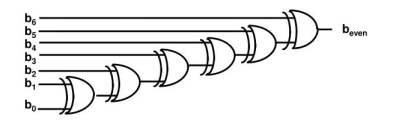
In the modern electronic components industry, parity generators and parity checkers play an indispensable role as components of logic integrated circuits, ensuring the reliability of data transmission. This article will introduce the concept of parity checking, types, characteristics, advantages, and application areas of these key components.
I. What is Parity Checking?
Parity checking is a method used to detect and correct errors in data transmission. During data transmission, each data packet is accompanied by an additional bit called a parity check bit. Based on the value of the check bit (even or odd), the receiving end can determine whether there are errors in the transmitted data. If the received data doesn't match the check bit, the system will issue a warning or perform error correction.
There are two types of parity checking: even parity and odd parity.
· Even Parity: In even parity, if the number of 1s in the data is even, the check bit added to the data is 0 to ensure that the total number of bits in the transmitted data is even.
· Odd Parity: In odd parity, if the number of 1s in the data is odd, the check bit added to the data is 0 to ensure that the total number of bits in the transmitted data is odd. These two types of checkers play important roles in different application scenarios, providing reliable protection for data transmission.
II. What is a Parity Generator?
A parity generator is a logic circuit used to generate parity check bits during data transmission. It checks the number of 1s in the data to be transmitted and generates the corresponding parity check bits based on parity.

Parity generators are typically divided into two types based on the desired parity rules: even parity generators and odd parity generators.
· Even Parity Generator: In even parity, the check bit is set to ensure that the number of 1s in the data is even. The even parity generator checks the number of bits in the data to be transmitted, and if there is an odd number of 1s, it adds a 1 to the check bit to ensure that the total number of 1s is even.
· Odd Parity Generator: Conversely, the odd parity generator ensures that the number of 1s in the data is odd. If there is an even number of 1s in the data to be transmitted, it adds a 1 to the check bit to ensure that the total number of 1s is odd.
III. What is a Parity Checker?
A parity checker is a logic circuit used to check for errors in data transmission. It compares the received data with the parity check bits added during transmission to determine the accuracy of data transmission. If they don't match, it indicates errors in data transmission.

Parity checkers can also be divided into even parity checkers and odd parity checkers.
· Even Parity Checker: This type of parity checker is used to check if there is an even number of 1s in the received data to ensure the accuracy of data transmission.
· Odd Parity Checker: This type of parity checker is used to check if there is an odd number of 1s in the received data to ensure the accuracy of data transmission.
IV. Characteristics and Advantages
Parity generators and parity checkers have the following characteristics and advantages:
· Reliability: Parity generators and checkers provide highly reliable data transmission, ensuring data integrity and accuracy.
· Simplicity: Their design is relatively simple, making them easy to integrate into various electronic systems.
· Real-time: Parity checking can detect errors in data transmission in real-time, correcting errors promptly during data transmission.
V. Applications
Parity generators and checkers have a wide range of applications in the electronics industry, covering multiple fields including but not limited to:
· Network Security: In networks, parity checking is used to detect and prevent tampering or forgery of data packets. Firewalls and Intrusion Detection Systems (IDS) typically use parity checking technology to verify the integrity of data packets to identify potential security threats.
· Storage Systems: In computer storage systems, parity checkers are commonly used in memory modules and disk drives to ensure data integrity and reliability. For example, hard disk drives use parity check bits to detect and correct errors in data stored on disks.
· Communication Devices: Used in modems and communication protocols to ensure that data is not corrupted or tampered with during transmission. For instance, in serial communication, UART (Universal Asynchronous Receiver/Transmitter) chips typically use parity checking to detect errors during data transmission and correct them when necessary.
VI. Conclusion
Parity generators and checkers are crucial components in the electronics industry, essential for ensuring the reliability and security of data transmission. Their ongoing development and improvement will further drive advancements in electronic communication technology, bringing more convenience and efficiency to people's lives and work.




